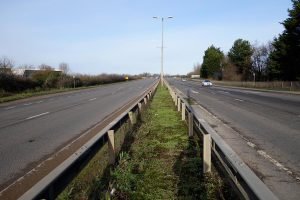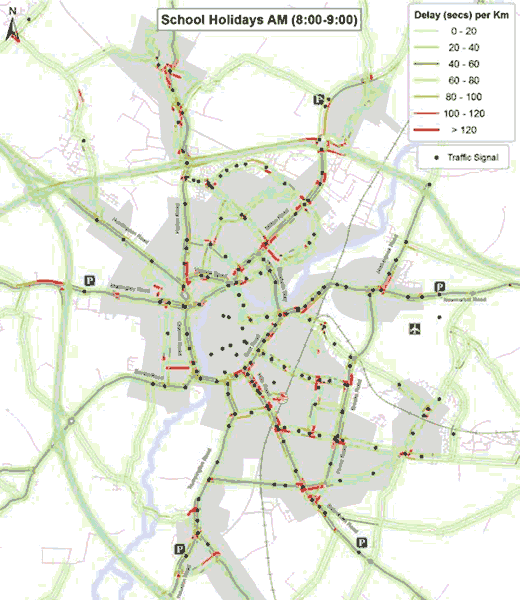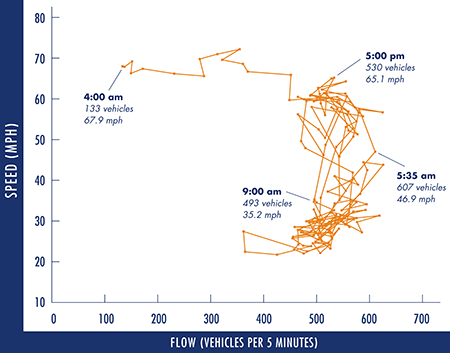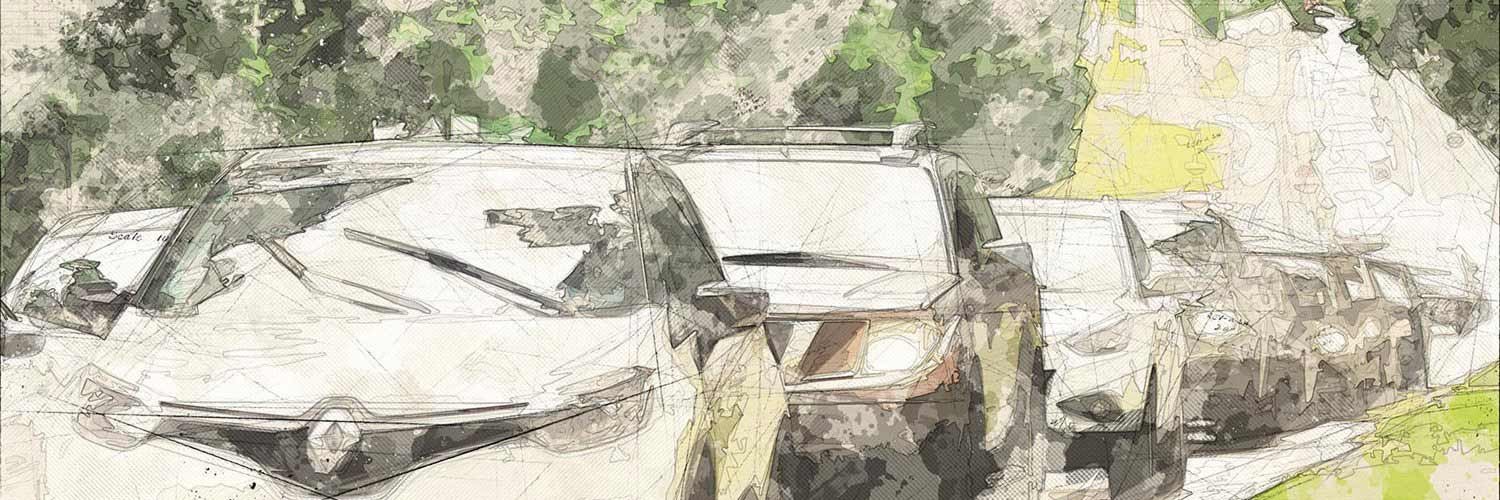What is Inbound Flow Control?
Inbound Flow Control is a powerful technique for reducing congestion. Traffic lights on the edge of the city release vehicles only as fast as the road ahead can carry them. By restricting flow at peak times in this way, congestion is experienced (if at all) only at the edges of the city: some of the traffic that would otherwise be sitting in a queue within the city (potentially blocking a junction) is ‘relocated’ to the edge of the city, where there is space (or space can more easily be created) to hold it.
A bypass lane or route allows buses (and emergency services) to jump to the head of the queue and join a single stream of free-flowing traffic into the city.
Roadside signs inform drivers of expected queuing times and provide directions to the nearest park-and-ride site.
What do you mean by a bypass route?
In some cases, rather than building a bypass lane, buses can use an alternative route. For instance Worts’ Causeway could provide a convenient route from the Babraham park-and-ride avoiding any queue along Babraham Road.
Where can I see it in action?
See this Streetfilms video of a similar traffic management system in Zurich, Switzerland (fast forward 5 minutes 20 seconds if you’re in a hurry):
How does this relate to ‘Smart Traffic Management’ and ‘gating’?
Inbound Flow Control depends on having a Smart Traffic Management system installed. It is known technically as ‘gating’, and sometimes as ‘queue relocation’ or, in the context of motorways, ‘ramp metering’. The traffic lights controlling flow into the city are known as ‘gates’ or ‘control points’.
How will Inbound Flow Control benefit me?
I drive
Your journey time will be no worse, and mostly likely quicker than now. Advance notice of queuing times will help you calculate your journey time and decide when to travel. Within Cambridge, journey times will be considerably quicker. However, we are also proposing measures to deter residents from taking to their cars, including restricting through traffic on more city roads.
Improvements to public transport, park-and-ride, and more safe cycle routes may offer you a quicker and more convenient alternative to driving.
I take the bus
Journey times into and within the city will be much more consistent and quicker. See our other proposals for reorganising bus services to provide express services to major centres of employment, education and retail.
I cycle
Lower volumes of motor vehicles will allow highways engineers to enhance your safety by:
- building segregated cycle lanes where otherwise they might have built bus lanes;
- installing advance green signals at all major junctions, greatly improving your safety;
- redesigning junctions to reduce conflict with motor vehicles and pedestrians.
Calmer drivers are less likely to behave aggressively towards you.
I walk
Lower volumes of motor vehicles will allow highways engineers to:
- build segregated cycle lanes where cyclists might otherwise have shared a footway;
- install more pedestrian crossings, especially near shops and other amenities;
- reduce the time you have to wait at pedestrian crossings.
Calmer drivers are less likely to behave aggressively towards you.
How big will the queues be?
If no other transport options were made available, then peak-time queues entering the city would be somewhat longer than now, but journey times would be more consistent and generally quicker, because of smoother traffic flow in the city.
We expect queues to shorten over time as people choose other travel options, encouraged by a mix of incentives and disincentives which we outline below.
On days and times when congestion is not now a problem (such as during school holidays and in the middle of the day), Inbound Flow Control will not kick in, and there will be no queuing.
Can I have some figures?
At most 20% of the vehicles on a road need to be held back in order to keep it congestion free. Relocating those vehicles to before the traffic ‘gate’ requires the same length of road that they would occupy after the ‘gate’. So the maximum additional queuing space required is 20% of the length of road beyond the gate.

Take Milton Road, which is 2.5km from the junction with Cowley Road and the Science Park to Mitcham’s Corner: 20% of that length is 500m, so that is how much additional space would be needed at a time when Milton Road would otherwise be gridlocked. That equates to around 50 vehicles. These may be accommodated easily by reconfiguring the road between the A14 interchange and the Science Park junction.
The total maximum queuing space required is therefore the current maximum distance that traffic tails back from where a ‘gate’ will be sited, plus 20% of the distance from the gate to the city centre.
However this is a theoretical maximum, which would not be required in practice because:
- Smart Traffic Management and Inbound Flow Control will minimise congestion within the city that can currently cause blocking back to junctions with the A14 or M11.
- Smart Traffic Management will also provide pre-programmed responses to overwhelming inflows of traffic on any radial by, for instance, temporarily holding all side roads at red, or diverting traffic onto alternative routes. Rapid dispersal or diversion of traffic will ensure that traffic never tails back dangerously onto the A14 or M11.
The actual amount of queuing space required will need to be modelled, ideally with data derived from live trials.
Where does that 20% figure come from?
Traffic flows freely until a road is carrying about 80% of its maximum capacity. Beyond that, the rate of flow becomes erratic until junctions get blocked and there’s gridlock.

People estimate that traffic volumes drop by as much as 40% during school holidays because congestion disappears from many roads (see animated comparison above of congestion during school term and school holidays). The measured reduction is in fact under 20%. (A study of traffic on Milton and Huntingdon Roads in October-November 2014 showed a drop in traffic of between 1.3% and 8.3% during the half-term week.) This is not to say that school parents are to blame for congestion (any more than the person to score the last goal in football wins the match): it merely shows that a relatively small reduction in traffic volume is enough to decongest the roads.

A study published by Berkeley University in California shows that the capacity of an uninterrupted road (a four-lane freeway in this case) is between 1,500 and 1,800 vehicles/lane/hour. Perhaps surprisingly, the peak flow rate is the same at 60mph as at 30mph: what changes is the spacing of the vehicles.
At 60mph, 1,800 vehicles/hour equates to 54m per vehicle. At 30mph, 1,800 vehicles/hour equates to 27m per vehicle. These are close to typical braking distances at those speeds.
Add 20% more traffic, the space available to each vehicle also reduces by 20% (and the space between vehicles slightly more). So drivers must slow down to maintain a safe stopping distance. But this reduces the flow rate, and congestion starts to set in.
On an urban road, with junctions and traffic lights, the peak flow rate is lower than 1,800 vehicles/hour, and comfortable vehicle spacings are greater because of the greater likelihood of needing to slow down or stop suddenly. But the same principle applies: if the net flow of traffic into a road reduces vehicle spacing to below a comfortable distance, traffic has to slow down, and congestion sets in.
How do you contain the queue?
In many cases it will be necessary to widen the road up to the control point with additional lanes, one of which may be the bypass lane.
This is generally much easier, cheaper and less controversial to do on the outskirts of the city than widening an inner city road to accommodate a bus lane:
- Trees and green spaces within the city are highly valued.
- Relocating or re-burying the large number of services (pipes and cables) under city roads and verges is expensive and disruptive.
- Holding and diverting traffic within the city during road works is much more disruptive than outside the city.
- Compulsorily purchasing land from multiple landowners in the city is considerably more complex and costly than purchasing a strip of farmland.
How will this work for Histon and Milton Roads?
Histon Road and Milton Road present a particular challenge because the A14 touches the north of the city, and these roads already see blocking back to the A14 exit ramps on occasion. It would therefore be pragmatic to create an additional 500m of queuing lane on Histon and Milton Roads, by some or all of the following means:
- South of the A14, widen Milton Road by one lane, and Histon Road by two or three lanes.
- Lengthen and widen the top of the A14 exit ramps.
- Widen the A10 and B1049 to the north of the A14.
To relieve pressure on the A14-Milton Rd roundabout, traffic from Milton village could be diverted during the morning peak via Butt Lane if the junction with the A10 were partially reinstated for a left-turn only. This junction could also provide a route for park-and-ride buses to bypass any queue on the A10. Milton residents could benefit from this if some buses stopped in the village.
Don’t we also need bus lanes?
The virtue of Inbound Flow Control is that it enables all inbound traffic – buses, commercial and private vehicles – to flow smoothly beyond the control point, so a bus lane is not needed.
As we explain in our paper on bus lanes, the benefit they provide is limited, partly because buses have to join the main flow of traffic in the city centre, at major junctions, and at pinch points (where the road is not wide enough to accommodate a bus lane).
A comprehensive implementation of Smart Traffic Management and Inbound Flow Control would make bus lanes work, but in reality that means it would make them redundant: buses will be running alongside traffic that is sufficiently free-flowing to accommodate those buses when they have to rejoin the main flow.
What about peak outbound traffic?
The volume of traffic leaving the city in the evening is related to the capacity of the city to accommodate vehicles, i.e. the number of available parking spaces, and the cost of accessing the city (which can be charged in various ways, but currently only involves a time-based charge to park in certain city centre locations).
Currently both of these factors are miscalibrated:
- We have more parking capacity than the roads can accommodate.
- The cost of access is nil for a large number of commuters who can park for free in residential streets.
We need to address both of these if we are to achieve a long-term reduction in congestion at both ends of the day. This will be the subject of other papers from us, but briefly, we anticipate proposing the following:
Residential parking
Extend parking controls to all residential roads in the city, and involve residents in determining what controls are used where, choosing from a range of options, including:
- All-day residents parking (to deter commuter and leisure parking)
- One-hour residents parking (to deter commuter parking)
- Double-yellow (no parking)
- Single-yellow (evening and weekend parking)
- Time-limited waiting (to deter commuter parking)
- Pay-and-display
- Cycle parking
Business parking
- Tax workplace parking spaces (following the example of Nottingham City Council).
- Provide grants or tax incentives to create secure, covered cycle parking.
City centre parking
- Convert more space within the city’s car parks to cycle parking.
- Remove on-street car parking that endangers cyclists.
- Convert more on-street parking space to cycle parking.
Provide convenient and attractive alternatives to driving
These are covered in our Ten Point Plan, which will be developed over the coming months.
Inbound Flow Control can help incentivise use of park-and-ride by providing a clear choice for drivers (e.g. queue for twenty minutes or catch a park-and-ride bus leaving in three minutes). The bypass lane ensures that park-and-ride buses can jump to the head of any queue.
Won’t residents gain an unfair benefit?
City residents (and visitors) will indeed benefit from having uncongested roads. If no other measures were implemented, some residents would succumb to the temptation of driving when currently they cycle or walk. Some of the measures listed in the previous section will affect residents, but we also propose measures to disincentivise short car journeys within the city:
- Apply the principal of the Core Traffic Scheme to more roads, such as Northampton St & East Rd, limiting through traffic to buses, taxis and delivery vehicles.
- Close more residential roads to through traffic (as, for instance, north Petersfield is now: there is no through route from Mill Road to Newmarket Road).
- Restrict movements at junctions between main and residential roads.
- Reduce parking provision (see previous section).
- Increase residents parking permit fees for second and third cars, to encourage a reduction in car ownership.
These measures will make residents think more carefully about whether they need to drive, but also have significant side benefits, in making more routes safer for cyclists and pedestrians, and making residential areas quieter and less polluted.
Can we trial it?
Yes, and we should. A trial would generate hard data and, hopefully, prove the effectiveness of Inbound Flow Control in achieving improved traffic flow in the city, and hence better bus reliability and journey times. It would also give the systems suppliers a degree of freedom to experiment which, for a relatively pioneering technique (at least in the UK), is essential.
If implemented on only some radial roads, Inbound Flow Control might induce people to seek alternative routes to avoid the queue. Even if this happens initially, people will quickly learn that journey times are no worse than before, and usually better. One of the key strengths of Inbound Flow Control is that it can be refined over time, even minute to minute, so if people overreact, it can be dialled down.
Who would be able to use the bypass lane?
The bypass lane could be treated as a bus lane, but we believe that the following road users should be eligible to use it, and should pay for the privilege:
- Buses and coaches (PSVs)
- Taxis
- Retail delivery vehicles (HGVs and LGVs)
- Couriers
Bus companies already pay to access park-and-ride sites, which are managed by the County Council, so paying to take advantage of Inbound Flow Control is not unreasonable.
Blue light emergency service vehicles would be granted a free pass.
So now you’re proposing a congestion charge?
Not exactly. A congestion charge would apply to all vehicles with limited exceptions. We are proposing an optional charge, which owners of vehicles could choose to pay in order to avoid waiting in a queue. The default charge would be set to be very unattractive, but owners of certain, mainly commercial, vehicles could apply for a lower rate. The justifications are:
- Councils will need a revenue stream to pay for running Smart Traffic Management, and to replace income lost from reducing city parking provision (one of our other recommendations).
- Time is money for businesses, and since the City Deal is about promoting economic growth, this allows businesses to optimise their efficiency and competitiveness.
- The fee structure can incentivise companies to use environmentally-friendly vehicles in the city.
How would people pay?
Vehicle owners would need to create an account, linked to a payment card or direct debit. Automatic Number Plate Recognition cameras would record each vehicle that uses the bypass lane and match it against a database of currently-registered vehicles. The owner of an unrecognised vehicle would have, say, 24 hours to create an account and pay in order to avoid a penalty charge notice.
Because use of the bypass lane would require pre-registration (unlike on toll roads), access could be monitored in real time and a warning message shown to a driver of an unrecognised vehicle.
This system could also work for access through point closures (bollarded roads) within the city, but with stricter eligibility criteria.
How much would people pay?
The default rate would be set high to be deliberately unattractive (say, £20), to ensure that the bypass lane does not itself become congested, nor hold the main queue at a standstill. Certain vehicle owners would be eligible to apply for a lower rate, according to criteria set out by the council. The applicable rate might depend on:
- the vehicle’s weight
- the vehicle’s emissions rating
- the typical use of the vehicle
- special circumstances, such as having a disability or being a named carer
The rate might range from free to £20 for a diesel HGV. This should raise a few million pounds per year.


